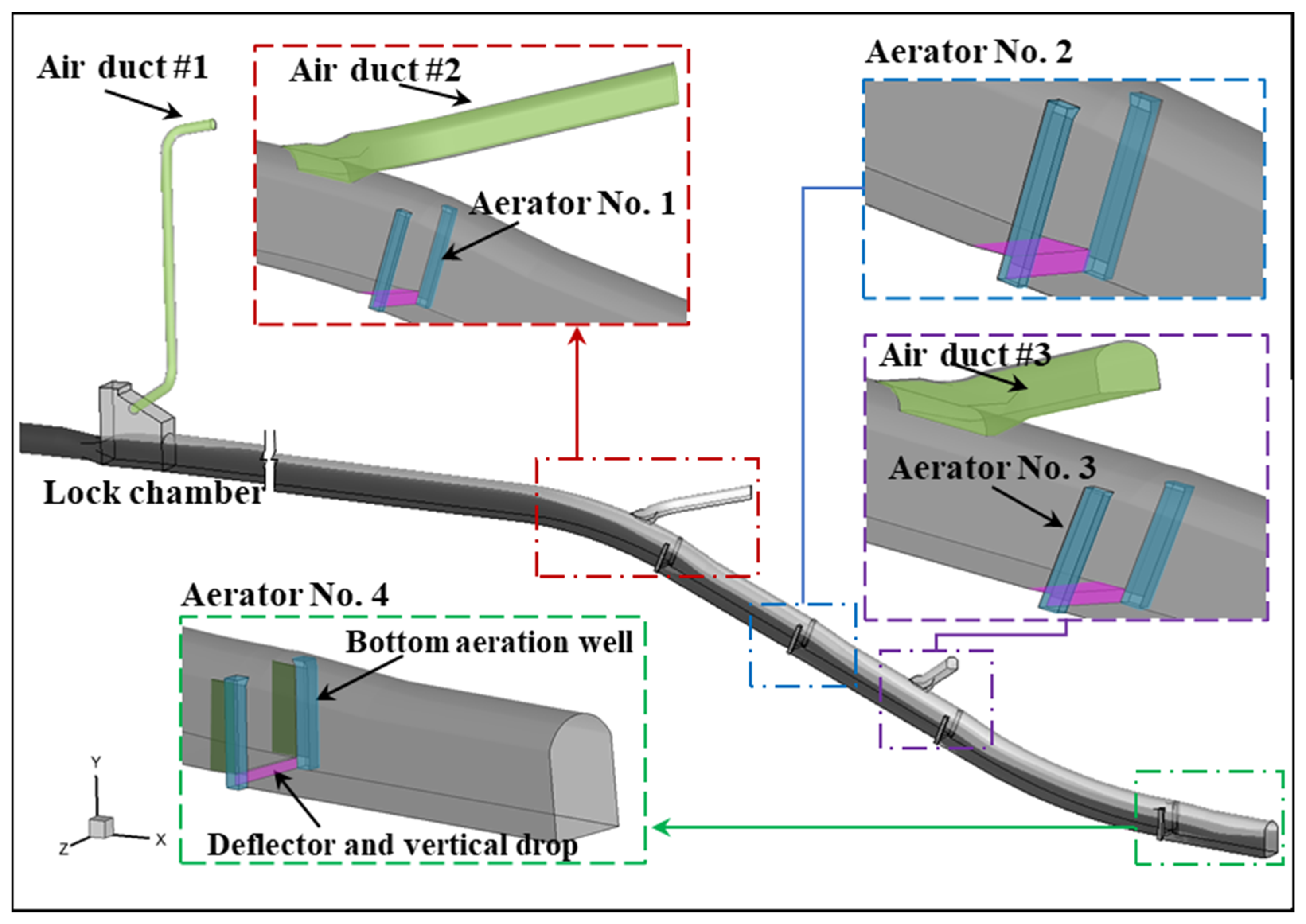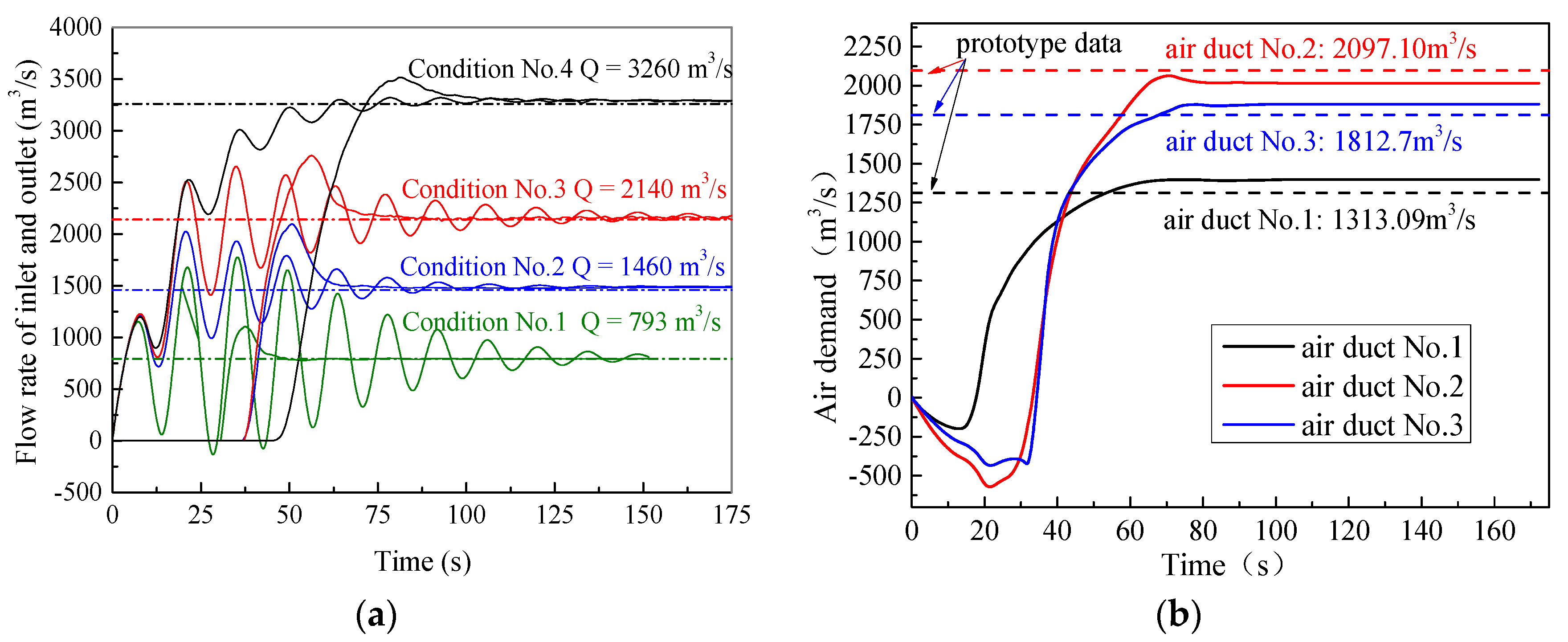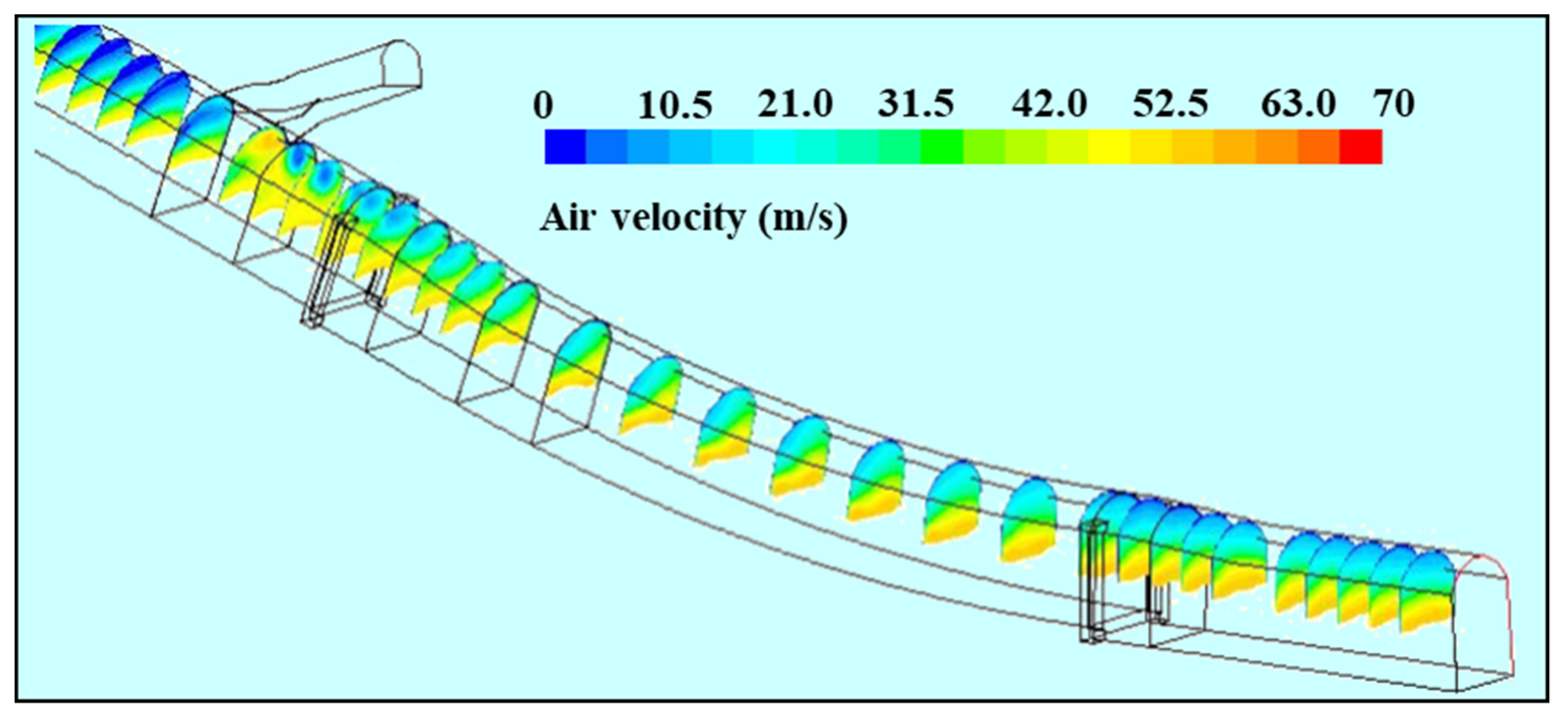Numerical Investigation on Air–Water Two-Phase Flow of Jinping-I Spillway Tunnel
Abstract
:Featured Application
Abstract
1. Introduction
2. Materials and Methods
2.1. Prototype Observation Results
2.2. Two-Fluid Model
2.2.1. Basic Equations
2.2.2. Interaction Forces
2.2.3. CFD Model Setup
3. Results
3.1. Verification
3.1.1. Grid Convergence
3.1.2. Time Independence
3.1.3. Air Demand and Velocity Profiles
3.1.4. Improvement of the Drag Model
4. Discussion
4.1. Air Velocity Distribution in Air Ducts
4.2. Water Tongue and Air Entrainment behind Aerators
4.3. Air Velocity above Water in the Tunnel
4.4. Flow Patterns
5. Conclusions
Author Contributions
Funding
Institutional Review Board Statement
Informed Consent Statement
Data Availability Statement
Conflicts of Interest
References
- Safavi, K.; Zarrati, A.R.; Attari, J. Experimental study of air demand in high head gated tunnels. Proc. Inst. Civ. Eng. Water Manag. 2008, 161, 105–111. [Google Scholar] [CrossRef]
- Lian, J.; Wang, X.; Ma, B.; Liu, D. Improvement to the sources selection to identify the low frequency noise induced by flood discharge. Mech. Syst. Signal Process. 2018, 110, 139–151. [Google Scholar] [CrossRef]
- Lian, J.; Wang, X.; Liu, D. Air demand prediction and air ducts design optimization method for spillway tunnel. J. Hydraul. Res. 2020, 59, 448–461. [Google Scholar] [CrossRef]
- Campbell, F.B.; Guyton, B. Air demand in gated outlet works. In Proceedings: Minnesota International Hydraulic Convention; ASCE: Reston, VA, USA, 2015. [Google Scholar]
- U.S. Army Corps of Engineers (USACE). Air Demand Regulated Outlet Works; Hydraulic Design Criteria: New York, NY, USA, 1964. [Google Scholar]
- Sharma, H.R. Air entrainment in high head gated conduits. J. Hydraul. Div. 1976, 102, 1629–1646. [Google Scholar] [CrossRef]
- Speerli, J.; Hager, W.H. Air-water flow in bottom outlets. Can. J. Civ. Eng. 2000, 27, 454–462. [Google Scholar] [CrossRef]
- Luo, H.Y. On the air intake problem of spillway tunnel. J. Hydraul. Eng. 1984, 8, 64–70. (In Chinese) [Google Scholar]
- Chen, Z.H.; Huang, W.; Ye, S. A study of prototype law of air demand in flood control conduits. J. Nanjing Hydraul. Res. Inst. 1986, 1, 1–18. (In Chinese) [Google Scholar]
- Deng, J. Investigation Report on the Air Demand in Flood Discharge Tunnel of High Dam Engineering; State Key Laboratory of Hydraulic and Mountain River Engineering, Sichuan University: Chengdu, China, 2017. (In Chinese) [Google Scholar]
- Lian, J.; Ren, P.; Qi, C. A brief theoretical analysis on the ventilation characteristics of the multi-intake-well air supply system in a spillway tunnel. Appl. Sci. 2019, 9, 2793. [Google Scholar] [CrossRef] [Green Version]
- Hohermuth, B.; Schmocker, L.; Boes, R.M. Air Demand of Low-Level Outlets for Large Dams. J. Hydraul. Eng. 2020, 146, 04020055. [Google Scholar] [CrossRef]
- Wei, W.; Deng, J.; Xu, W. Numerical investigation of air demand by the free surface tunnel flows. J. Hydraul. Res. 2020, 59, 158–165. [Google Scholar] [CrossRef]
- Yazdi, J.; Zarrati, A.R. An algorithm for calculating air demand in gated tunnels using 3D numerical model. J. Hydro-Environ. Res. 2011, 5, 3–13. [Google Scholar] [CrossRef]
- Liu, T.; Yang, J. Three-dimensional Computations of Water–Air Flow in a Bottom Spillway During Gate Opening. Eng. Appl. Comput. Fluid Mech. 2014, 8, 104–115. [Google Scholar] [CrossRef] [Green Version]
- Li, M.; Tian, Z. Influence of the ventilation area on the ventilation volume of the spillway tunnel and the wind field. Sichuan Water Power 2015, 34, 74–77. (In Chinese) [Google Scholar]
- Salazar, F.; San-Mauro, J.; Celigueta, M.A. Air demand estimation in bottom outlets with the particle finite element method. Comput. Part. Mech. 2017, 4, 1–12. [Google Scholar] [CrossRef] [Green Version]
- Yang, J.; Teng, P.; Xie, Q.; Li, S. Understanding Water Flows and Air Venting Features of Spillway—A Case Study. Water 2020, 12, 2106. [Google Scholar] [CrossRef]
- Wardle, K.E.; Weller, H.G. Hybrid Multiphase CFD Solver for Coupled Dispersed/ Segregated Flows in Liquid-Liquid Extraction. Int. J. Chem. Eng. 2013, 2013, 128936. [Google Scholar] [CrossRef]
- Ishii, M.; Mishima, K. Two-fluid model and hydrodynamic constitutive relations. Nucl. Eng. Des. 1984, 82, 107–126. [Google Scholar] [CrossRef]
- Rehman, K.U.; Shatanawi, W.; Malik, M.Y. Heat transfer and double sampling of stratification phenomena in non-Newtonian liquid suspension: A comparative thermal analysis. Case Stud. Therm. Eng. 2022, 33, 101934. [Google Scholar] [CrossRef]
- Munir, T.; Din, A.; Ullah, S.; Malik, M.Y.; Alqahtani, A.S. Discrete mass conservation and stability analysis of the ocean-atmosphere model with coupling conditions. J. Ocean Eng. Sci. 2022; in press. [Google Scholar] [CrossRef]
- Lian, J.; Qi, C.; Liu, F.; Gou, W.; Pan, S.; Ouyang, Q. Air Entrainment and Air Demand in the Spillway Tunnel at the Jinping-I Dam. Appl. Sci. 2017, 7, 930. [Google Scholar] [CrossRef] [Green Version]
- Simonnet, M.; Gentric, C.; Olmos, E.; Midoux, N. CFD simulation of the flow field in a bubble column reactor: Importance of the drag force formulation to describe regime transitions. Chem. Eng. Process. Process Intensif. 2008, 47, 1726–1737. [Google Scholar] [CrossRef]
- ANSYS Inc. ANSYS FLUENT Theory Guide; ANSYS Inc.: Canonsburg, PA, USA, 2016. [Google Scholar]
- Richardson, L.F. On the Approximate Arithmetical Solution by Finite Differences of Physical Problems Involving Differential Equations, with an Application to the Stresses in a Masonry Dam. Proc. R. Soc. Lond. 1910, 83, 335–336. [Google Scholar]















| Gate Opening Ratio | Flow Rate (m3/s) | Air Demand of Air Ducts (m3 s−1) | Average Aeration Concentration of Cross Section (%) | |||
|---|---|---|---|---|---|---|
| Duct No. 1 | Duct No. 2 | Duct No. 3 | Aerator No. 2 | Aerator No. 4 | ||
| 25% | 793 | 933.59 | 1402.13 | 892.08 | 27.79 | 32.19 |
| 50% | 1460 | 1258.51 | 1805.52 | 1119.53 | 20.72 | 27.00 |
| 75% | 2140 | 1543.3 | 2161.08 | 1495.33 | 17.35 | 22.11 |
| 100% | 3220 | 1313.09 | 2097.1 | 1812.71 | 12.57 | 16.10 |
| Air Duct No. 1 | Air Duct No. 2 | Air Duct No. 3 | |||||||
|---|---|---|---|---|---|---|---|---|---|
| Grid parameter | Cell counts: 323 w; 203 w; 72 w Equivalent size h: 0.5947; 0.6940; 0.9816 | ||||||||
| r21 = 1.1669; r32 = 1.4145 | |||||||||
| Air velocity (m/s) | 69.12 | 70.37 | 77.97 | 66.54 | 67.53 | 73.31 | 57.78 | 58.37 | 63.36 |
| φext | 67.5259 | 65.2104 | 57.2601 | ||||||
| ea | 1.81% | 1.49% | 1.02% | ||||||
| eext | 2.36% | 2.04% | 0.91% | ||||||
| GCIfine | 2.88% | 2.50% | 1.12% | ||||||
| Gate Opening Ratio | Flow Rate (m3/s) | Aerator No. 2 | Aerator No. 4 | ||||
|---|---|---|---|---|---|---|---|
| Calculated | Prototype | Error (%) | Calculated | Prototype | Error (%) | ||
| 25% | 793 | 31.68% | 27.79% | 13.99 | 36.29% | 32.19% | 12.74 |
| 50% | 1460 | 20.13% | 20.72% | −2.83 | 24.49% | 27.00% | −9.29 |
| 75% | 2140 | 14.08% | 17.35% | −18.82 | 17.63% | 22.11% | −20.25 |
| 100% | 3220 | 9.33% | 12.57% | −25.80 | 11.54% | 16.10% | −28.35 |
Publisher’s Note: MDPI stays neutral with regard to jurisdictional claims in published maps and institutional affiliations. |
© 2022 by the authors. Licensee MDPI, Basel, Switzerland. This article is an open access article distributed under the terms and conditions of the Creative Commons Attribution (CC BY) license (https://creativecommons.org/licenses/by/4.0/).
Share and Cite
Wang, X.; Lian, J. Numerical Investigation on Air–Water Two-Phase Flow of Jinping-I Spillway Tunnel. Appl. Sci. 2022, 12, 4311. https://doi.org/10.3390/app12094311
Wang X, Lian J. Numerical Investigation on Air–Water Two-Phase Flow of Jinping-I Spillway Tunnel. Applied Sciences. 2022; 12(9):4311. https://doi.org/10.3390/app12094311
Chicago/Turabian StyleWang, Xiaoqun, and Jijian Lian. 2022. "Numerical Investigation on Air–Water Two-Phase Flow of Jinping-I Spillway Tunnel" Applied Sciences 12, no. 9: 4311. https://doi.org/10.3390/app12094311
APA StyleWang, X., & Lian, J. (2022). Numerical Investigation on Air–Water Two-Phase Flow of Jinping-I Spillway Tunnel. Applied Sciences, 12(9), 4311. https://doi.org/10.3390/app12094311






